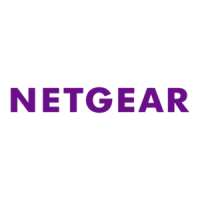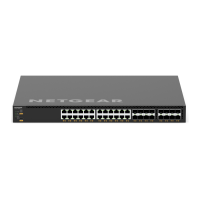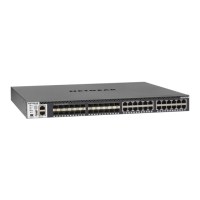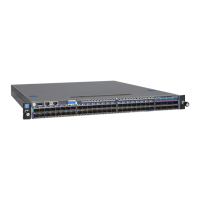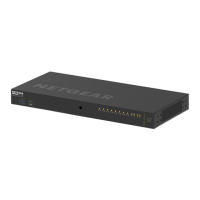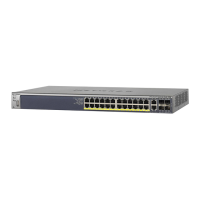Routing
322
M4300 Series and M4300-96X Fully Managed Switches User Manual
This value must be entered in dotted-decimal notation.
14. Select the Source Interface for this tunnel.
The address associated with the selected interface is used as the source address.
15. Enter the Destination Address for this tunnel in dotted-decimal notation.
16. Click the Add button.
The tunnel is added.
17. Click the Apply button.
Your settings are saved.
The Interface Link Status field indicates whether the tunnel interface is up or down.
VLAN Overview
You can configure the switch software so that some ports support VLANs and other ports
support routing. You can also configure the software to allow traffic on a VLAN to be treated
as if the VLAN were a router port.
When a port is enabled for bridging (default) rather than routing, all normal bridge processing
is performed for an inbound packet, which is then associated with a VLAN. Its MAC
destination address (MAC DA) and VLAN ID are used to search the MAC address table. If
routing is enabled for the VLAN, and the MAC DA of an inbound unicast packet is that of the
internal bridge-router interface, the packet is routed.
An inbound multicast packet is
forwarded to all ports in the VLAN, plus the internal bridge-router interface, if it was received
on a routed VLAN.
Since a port can be configured to belong to more than one VLAN, VLAN routing might be
enabled for all of the VLANs on the port, or for a subset. VLAN routing can be used to allow
more than one physical port to reside on the same subnet. It could also be used when a
VLAN spans multiple physical networks, or when additional segmentation or security is
required.
This section shows how to configure the NETGEAR switch to support VLAN
routing.
A port can be either a VLAN port or a router port, but not both. However, a VLAN port
can be part of a VLAN that is a router port.
Use the VLAN Static Routing Wizard
The VLAN Static Routing Wizard creates a VLAN, adds selected ports to the VLAN. The
VLAN Static Routing Wizard gives you the option to add the selected ports as a link
aggregation (LAG). The Wizard does the following:
• Creates a VLAN and generates a unique name for VLAN.
• Adds selected ports to the newly created VLAN and removes selected ports from the
default VLAN.
• Creates a LAG, add selected ports to a LAG, then adds a LAG to the newly created
VLAN.
